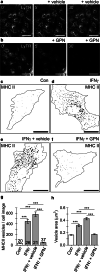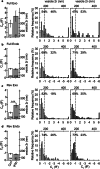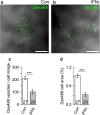Exocytosis of large-diameter lysosomes mediates interferon γ-induced relocation of MHC class II molecules toward the surface of astrocytes
- PMID: 31667557
- PMCID: PMC7391398
- DOI: 10.1007/s00018-019-03350-8
Exocytosis of large-diameter lysosomes mediates interferon γ-induced relocation of MHC class II molecules toward the surface of astrocytes
Abstract
Astrocytes are the key homeostatic cells in the central nervous system; initiation of reactive astrogliosis contributes to neuroinflammation. Pro-inflammatory cytokine interferon γ (IFNγ) induces the expression of the major histocompatibility complex class II (MHCII) molecules, involved in antigen presentation in reactive astrocytes. The pathway for MHCII delivery to the astrocyte plasma membrane, where MHCII present antigens, is unknown. Rat astrocytes in culture and in organotypic slices were exposed to IFNγ to induce reactive astrogliosis. Astrocytes were probed with optophysiologic tools to investigate subcellular localization of immunolabeled MHCII, and with electrophysiology to characterize interactions of single vesicles with the plasmalemma. In culture and in organotypic slices, IFNγ augmented the astrocytic expression of MHCII, which prominently co-localized with lysosomal marker LAMP1-EGFP, modestly co-localized with Rab7, and did not co-localize with endosomal markers Rab4A, EEA1, and TPC1. MHCII lysosomal localization was corroborated by treatment with the lysosomolytic agent glycyl-L-phenylalanine-β-naphthylamide, which reduced the number of MHCII-positive vesicles. The surface presence of MHCII was revealed by immunolabeling of live non-permeabilized cells. In IFNγ-treated astrocytes, an increased fraction of large-diameter exocytotic vesicles (lysosome-like vesicles) with prolonged fusion pore dwell time and larger pore conductance was recorded, whereas the rate of endocytosis was decreased. Stimulation with ATP, which triggers cytosolic calcium signaling, increased the frequency of exocytotic events, whereas the frequency of full endocytosis was further reduced. In IFNγ-treated astrocytes, MHCII-linked antigen surface presentation is mediated by increased lysosomal exocytosis, whereas surface retention of antigens is prolonged by concomitant inhibition of endocytosis.
Keywords: Adaptive immunity; Astroglia; Fusion pore; Inflammatory cytokines; Lysosomes; Patch clamp.
Figures









Similar articles
-
Endosomally stored MHC class II does not contribute to antigen presentation by dendritic cells at inflammatory conditions.Traffic. 2011 Aug;12(8):1025-36. doi: 10.1111/j.1600-0854.2011.01212.x. Epub 2011 May 13. Traffic. 2011. PMID: 21518167
-
IFN-γ-induced increase in the mobility of MHC class II compartments in astrocytes depends on intermediate filaments.J Neuroinflammation. 2012 Jun 26;9:144. doi: 10.1186/1742-2094-9-144. J Neuroinflammation. 2012. PMID: 22734718 Free PMC article.
-
Dendritic cell maturation triggers retrograde MHC class II transport from lysosomes to the plasma membrane.Nature. 2002 Aug 29;418(6901):988-94. doi: 10.1038/nature01006. Nature. 2002. PMID: 12198549
-
Gliocrine System: Astroglia as Secretory Cells of the CNS.Adv Exp Med Biol. 2019;1175:93-115. doi: 10.1007/978-981-13-9913-8_4. Adv Exp Med Biol. 2019. PMID: 31583585 Free PMC article. Review.
-
MHC class II antigen presentation by dendritic cells regulated through endosomal sorting.Cold Spring Harb Perspect Biol. 2013 Dec 1;5(12):a016873. doi: 10.1101/cshperspect.a016873. Cold Spring Harb Perspect Biol. 2013. PMID: 24296169 Free PMC article. Review.
Cited by
-
Exocytosis in Astrocytes.Biomolecules. 2021 Sep 16;11(9):1367. doi: 10.3390/biom11091367. Biomolecules. 2021. PMID: 34572580 Free PMC article. Review.
-
Astrocyte Mitochondria in White-Matter Injury.Neurochem Res. 2021 Oct;46(10):2696-2714. doi: 10.1007/s11064-021-03239-8. Epub 2021 Feb 1. Neurochem Res. 2021. PMID: 33527218 Free PMC article. Review.
-
Neurotropic Viruses, Astrocytes, and COVID-19.Front Cell Neurosci. 2021 Apr 9;15:662578. doi: 10.3389/fncel.2021.662578. eCollection 2021. Front Cell Neurosci. 2021. PMID: 33897376 Free PMC article. Review.
-
Cathepsin S activation contributes to elevated CX3CL1 (fractalkine) levels in tears of a Sjögren's syndrome murine model.Sci Rep. 2020 Jan 29;10(1):1455. doi: 10.1038/s41598-020-58337-4. Sci Rep. 2020. PMID: 31996771 Free PMC article.
-
Lysosomal Functions in Glia Associated with Neurodegeneration.Biomolecules. 2021 Mar 9;11(3):400. doi: 10.3390/biom11030400. Biomolecules. 2021. PMID: 33803137 Free PMC article. Review.
References
MeSH terms
Substances
Grants and funding
LinkOut - more resources
Full Text Sources
Research Materials
Miscellaneous

